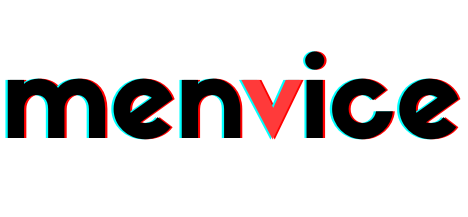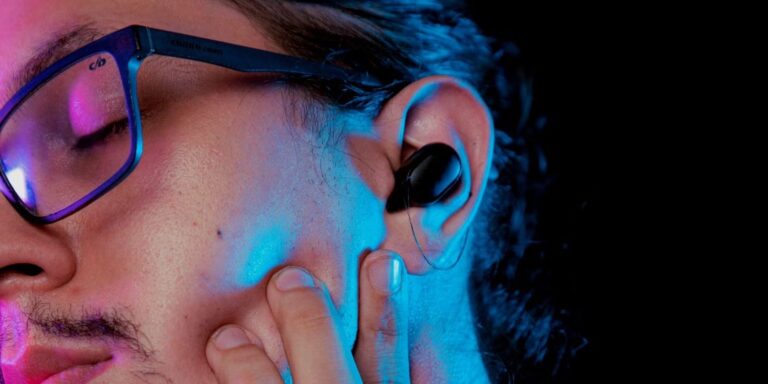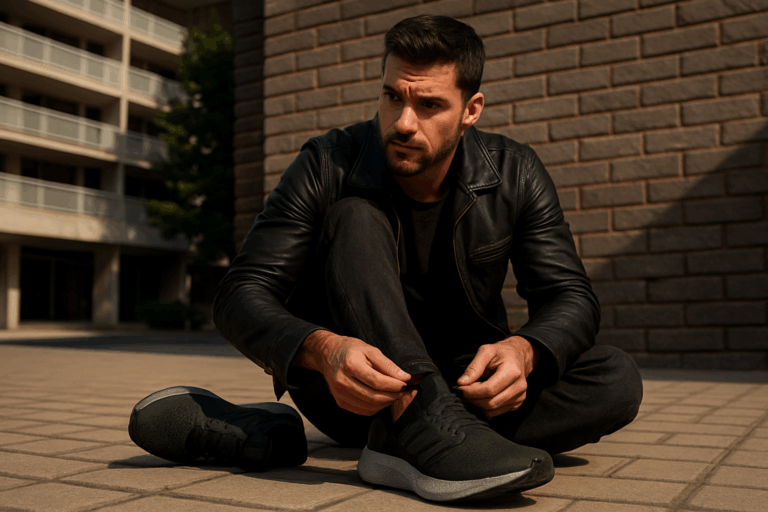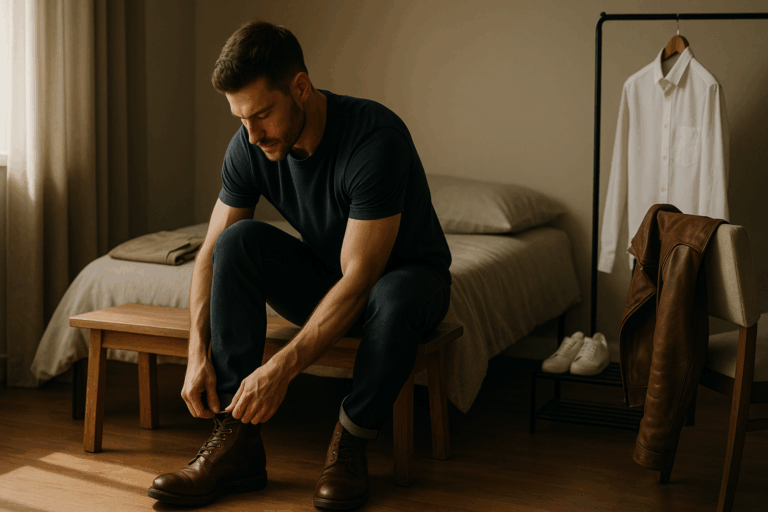
Elegance in Rebellion.
Own the Edge.
Why a Belt Is More Than Just an Accessory: The 4 Belts That Will Instantly Elevate Your Style
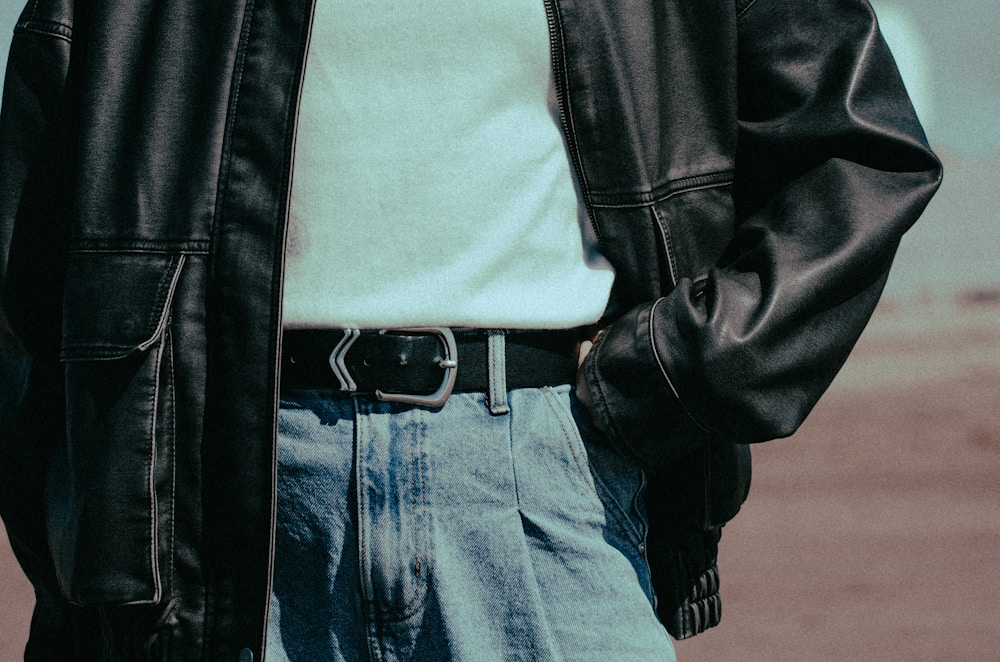
Walk out of the house without a belt and something will always feel missing. It’s not just about holding up your trousers. The belt has become one of the few accessories men wear on a daily basis — and it speaks louder than most realize. A watch might catch attention only when you raise your hand. A bracelet or a chain may not even be noticed. But your belt? It sits at the center of your body, dividing your outfit into two halves, quietly pulling the entire look together.
A Short History of Belts
Belts weren’t always about style. In the early days, they were military essentials. Soldiers wore them to secure weapons and gear, not to cinch slim-fit trousers. In fact, before the early 20th century, suspenders were the common way men kept their pants in place. The belt only gained dominance when high-waisted trousers started dropping lower, making suspenders impractical. By the 1920s, belts were standard, and men were quick to recognize that the strip of leather around their waist was also a strip of personality.
From rugged cowboy belts with heavy buckles to the slim leather straps worn by Wall Street bankers, the belt evolved into a signal. It told people who you were before you even opened your mouth.
The Everyday Utility
At its core, a belt still has a job: keeping your pants in place. Sounds obvious, but try spending a day without one and you’ll realize how often you rely on it. Sitting down, standing up, reaching for something, or just walking down the street — that tension around your waist provides security. Without it, your trousers shift and sag, you’re constantly adjusting, and nothing feels sharp.
A man who wears a belt moves differently. There’s a quiet assurance in knowing your clothes stay where they should. It’s like the hidden confidence of wearing well-fitted underwear. You don’t flaunt it, but it shapes the way you carry yourself.
The Line That Divides
Look at any well-dressed man and notice how his belt functions as a visual divider. It breaks the torso from the legs, balancing proportions. Without it, especially if you’re wearing tucked-in shirts, the outfit looks incomplete — like a painting without a frame.
This dividing line is powerful. A sleek black belt against grey trousers and a crisp white shirt creates contrast that feels deliberate. A brown leather belt paired with denim makes the outfit feel grounded and masculine. Even when no one consciously notices your belt, they’re reacting to the structure it gives your appearance.
Color and Coordination
The golden rule: your belt should match your shoes. Brown shoes with a brown belt. Black shoes with a black belt. Sounds simple, but men trip over this all the time. That one mismatch can ruin the effort you put into the rest of the outfit.
Of course, within that rule, there’s range. Light brown shoes go best with lighter shades of brown belts. Ox-blood leather pairs well with burgundy belts. Suede shoes? A suede belt is the cleanest match. The closer the textures and tones, the more seamless the look.
And it’s not just about shoes. Belts echo other elements. A silver buckle pairs with a silver watch, cufflinks, or even zippers. A brass buckle resonates with warmer accessories. These small consistencies separate the man who dresses with intention from the man who just throws clothes together.
Casual Belts vs. Formal Belts
Not all belts are equal, and the daily wear depends on the situation.
- Formal Belts: Slim, polished leather with a simple buckle. Usually in black or dark brown. No frills, no oversized logos. These belts are designed to vanish into a suit, to support without stealing attention. If your office has a dress code, this is the belt that saves you every morning.
- Casual Belts: Wider, often with texture or stitching. Sometimes in rugged leathers, sometimes in canvas. Casual belts add personality. They work with jeans, chinos, even shorts. This is where you can explore buckles with more presence or colors that break tradition.
Every man should own at least two of each — because the wrong belt with the wrong outfit will always look like an afterthought.
The Psychology of Wearing a Belt
Here’s what most men don’t think about: a belt signals discipline. It says you care enough to keep things together. Sagging trousers suggest carelessness. A polished belt says order. It’s the same reason military uniforms always highlight the waistline — the belt becomes a symbol of control.
Even in business, people notice. A boss who sees a young professional with scuffed shoes and a worn-out belt will register the lack of detail. Clients pick up on it too, even unconsciously. The man who pays attention to the small things is often trusted with the big things.
The Subtle Flex
Belts are one of the few places men can flex style without overdoing it. A watch might be too flashy. Rings might not be your thing. But a belt? It’s expected. Nobody thinks you’re showing off when you wear a good one. Yet the difference between a cheap, synthetic belt and a handcrafted leather strap is obvious to anyone with taste.
It’s in the way the leather ages, the way it molds to your body, the sound it makes when the prong clicks into place. High-quality belts develop patina; cheap belts crack and peel. Over time, your belt tells a story — and the story should be one of refinement, not neglect.
Belts and Body Shape
Most men don’t realize belts can also shape how their body looks. A belt at the natural waistline elongates the legs, making you appear taller. A thicker belt can emphasize a broad torso, while a thinner one keeps things sleek. The color contrast can either break up your silhouette or create a continuous flow, depending on how you wear it.
This is why some men look “put together” even in jeans and a plain T-shirt — the belt is quietly balancing proportions.
Daily Wear and Rotation
Belts work hard, often harder than shoes. You twist, bend, and pull on them every single day. Leather needs rest, just like shoes do. Wearing the same belt seven days a week guarantees premature wear. That’s why every man should rotate at least three or four belts for daily use — not for variety’s sake, but for longevity.
Keep one black formal belt, one brown formal belt, one casual brown belt, and one casual black or textured belt. That rotation covers almost everything, from boardroom to weekend.
Care and Maintenance
A belt isn’t something you throw on the chair at night. Real leather responds to how you treat it. Hang your belts vertically or roll them loosely. Avoid folding them harshly, which creates permanent creases. Every few months, wipe them clean and condition them with leather cream — the same way you’d take care of quality shoes.
Canvas and fabric belts can be spot-cleaned, but avoid running them through harsh washes. A dirty belt ruins the sharpness of an otherwise crisp outfit.
When the Belt Should Disappear
Interestingly, there are moments when skipping a belt is intentional style. Minimalist tailoring sometimes eliminates belt loops altogether, especially in custom suits or tuxedos. In that case, braces or side adjusters take over. But this only works in highly tailored environments. For daily wear, especially with jeans, chinos, or off-the-rack trousers, the absence of a belt looks careless, not deliberate.
So, here are my top 4 recommendations for belts that can add the WOW in your wardrobe!
1. HALDEN Micro Fiber Suede Belt for Men
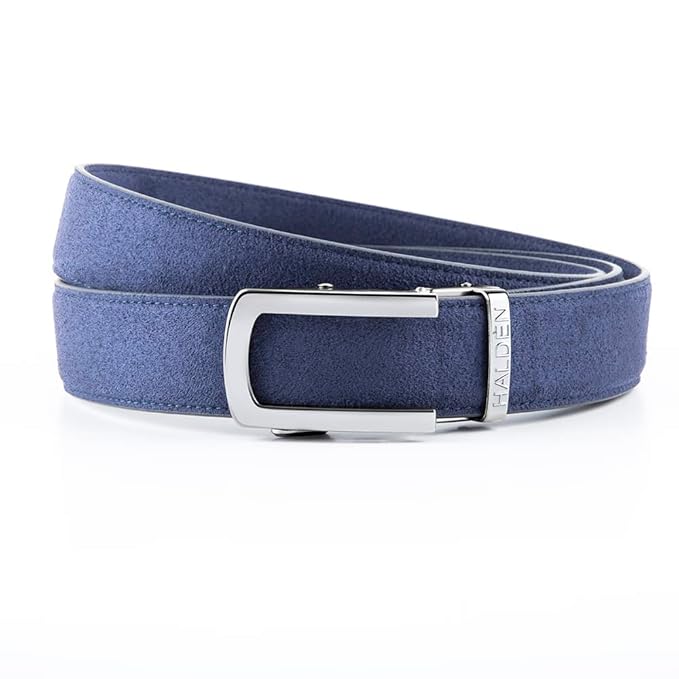
- Key Features:
- Microfiber suede (100% vegan)
- Ratchet strap mechanism (magnetic auto-lock buckle)
- Fits waists up to 44 inches
This belt is perfect for the man who values comfort and sustainability. Traditional belts rely on holes punched every inch, but ratchet belts allow you to micro-adjust in tiny increments. That means you’ll always get the perfect snugness after a big meal or during long office hours.
Use Case:
- Daily office wear if you don’t want to fuss with sizing
- Vegan-conscious men avoiding animal leather
- A smarter alternative to elastic belts
2. Da Milano Non-Reversible Leather Belt for Men
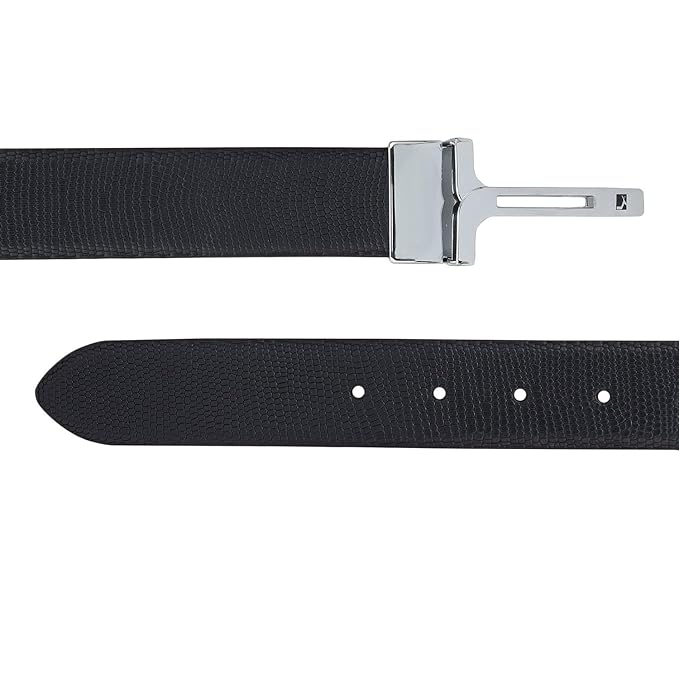
- Key Features:
- Premium Da Milano craftsmanship
- Genuine leather
- Navy color for versatility
If black and brown dominate your belt drawer, a navy leather belt adds a fresh twist. It’s subtle enough to pair with grey trousers or dark denim but still stands out against lighter chinos.
Use Case:
- Men who already own classic belts and want a versatile “third color”
- Office executives upgrading from fast-fashion belts to premium leather
- Ideal for semi-formal and business casual wear
3. ITIEZY Leather Ratchet Belt (Vintage Style)
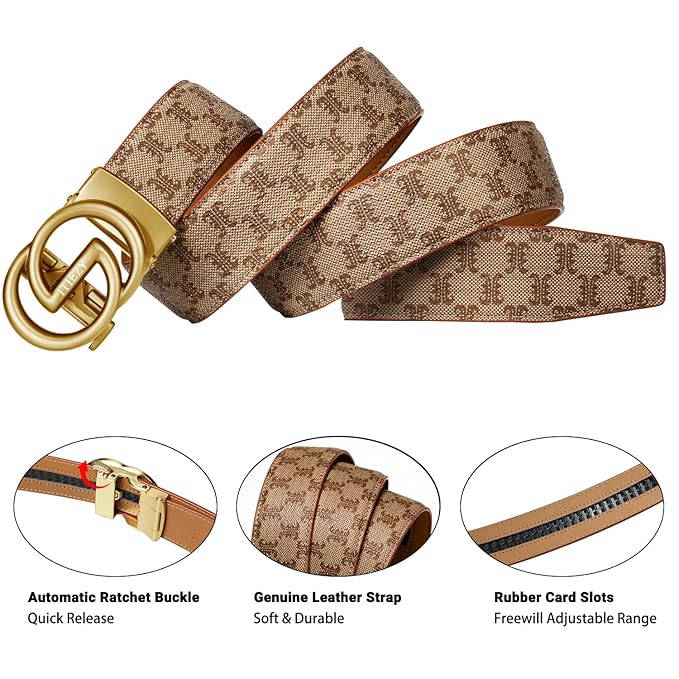
- Key Features:
- Ratchet sliding buckle (no holes)
- Adjustable trim-to-fit system
- Vintage leather finish
This belt bridges tradition and modernity. The leather finish keeps it classic, while the ratchet buckle makes it ultra-practical. Unlike the HALDEN suede belt (vegan), ITIEZY gives you the authentic leather touch with modern adjustability.
Use Case:
- Men who prefer leather but want the comfort of a ratchet belt
- Great for jeans, chinos, and everyday wear
- Those tired of worn-out belt holes stretching over time
4. Timberland Men’s Classic Leather Reversible Belt
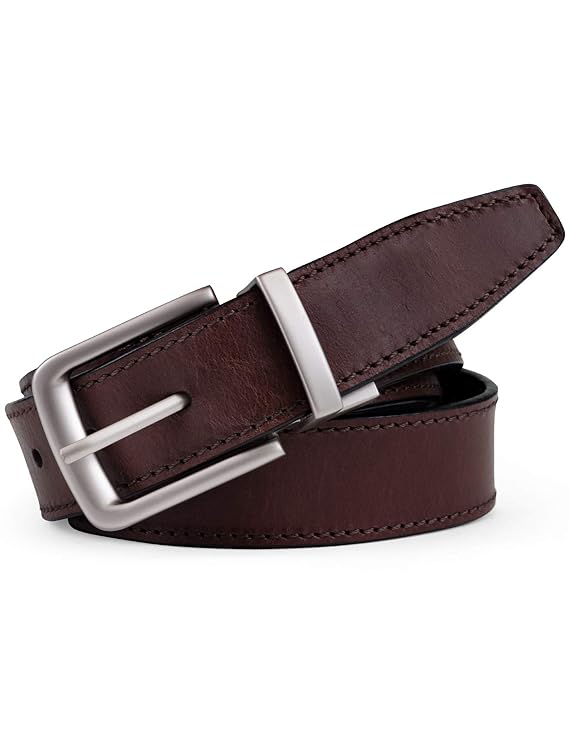
- Key Features:
- 100% leather
- Two-in-one reversible design (black & brown)
- Sturdy Timberland craftsmanship
A reversible belt is a must-have for travel and minimal wardrobes. With just one belt, you cover both black and brown shoe combinations. Timberland adds rugged reliability, making this a long-lasting essential.
Use Case:
- Business travelers who want one belt for multiple outfits
- Men starting a capsule wardrobe
- Everyday wear for those who don’t want clutter
Choosing the Right Belt for Your Wardrobe
When picking a belt, here’s what to keep in mind:
1. Material Matters
- Genuine leather = timeless, durable, formal
- Vegan microfiber = eco-friendly, modern, easy to maintain
- Suede = stylish but best for casual and semi-formal outfits
2. Width
- 1–1.25 inches = formal belts for trousers and suits
- 1.5 inches = casual belts for jeans and chinos
3. Buckle Style
- Polished metal = suits and dress wear
- Brushed metal or matte = casual and rugged looks
- Ratchet/magnetic = modern, convenient, and precise
4. Color Coordination
Always match your belt with your shoes (and preferably your watch strap if leather). Black shoes = black belt. Brown shoes = brown belt. Navy belts? They work best with dark brown or oxblood shoes.
Quick Comparison: Best Belts for Men in 2025
| Belt | Material | Mechanism | Best For | Price Segment |
|---|---|---|---|---|
| HALDEN Micro Fiber Suede | Vegan suede | Ratchet magnetic buckle | Daily wear, eco-conscious men | Affordable |
| Da Milano Navy | Premium leather | Traditional | Semi-formal/business casual | Premium |
| ITIEZY Vintage Ratchet | Leather | Ratchet buckle | Casual + smart wear | Mid-range |
| Timberland Reversible | Leather | Classic buckle, reversible | Travel, capsule wardrobes | Mid-premium |
How Many Belts Do You Really Need?
If you want to build a no-nonsense wardrobe, here’s the formula:
- Black leather formal belt (office, weddings, formal wear)
- Brown leather belt (suits, chinos, business casual)
- Casual belt (jeans, suede, or canvas)
- Ratchet/magnetic belt (daily wear comfort)
- Reversible belt (travel, quick fixes)
That’s it. With these five, you’ll be covered for almost any occasion.
